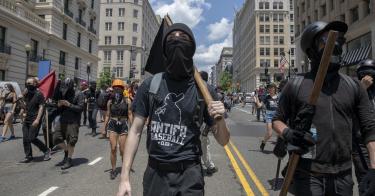If you’ve watched a modern protest long enough, you see the same set pieces: branded signs, travel vans, legal observers at the ready, and polished spokespeople who know exactly when to get on camera. It reads like chaos — loud, spontaneous, raw. It is not. Antifa is a franchise. Small, mobile units execute the act; a larger apparatus pays for the megaphones, the buses and the PR. The headline reads “spontaneous uprising.” The ledger reads “vendor payments, invoice 1123.”
There’s an advantage to this framing beyond theatrical displeasure: it gives you a problem you can actually fix. If unrest behaves like a consumer product — with logistics, budgets, and repeatable production values — then auditing, disclosure, and enforcement can work like quality control. If you insist on describing every iteration as a leaderless moment of moral urgency, you remove the trail, and every accountability playbook becomes a parlor trick.
The playbook is predictable. Fiscal sponsors accept donations and route money to local chapters under the benign language of “community programming” or “mutual aid.” Consultants and event planners invoice for travel logistics and media buys. Legal-defense funds collect retainers. Nonprofits with a mission statement about “empowerment” or “direct action” pay for transportation and hotel blocks in a way that looks like grantmaking on paper but operates like campaign finance in practice. The cash doesn’t shout; it wires.
Local governments make this easier in two ways. First, posture: a mayor fearful of being labeled heavy-handed will publicly celebrate restraint, then privately outsource the problem to PR teams that manage optics while the city sleeps. Second, procurement: governments and quasi-governmental entities increasingly buy into community programs and contractor networks that can be — intentionally or negligently — retooled as protest infrastructure. That creates plausible deniability and a recurring supplier relationship rather than a one-off disruption.
This model should be obvious. But obvious rarely makes for good television, and it makes for lousy incentives in political offices. Political careers are optimized for symmetry in sound bites, not for chasing bank-to-bank transfers. Audits don’t trend. Subpoenas are boring. So we get committees and speeches and televised panels that announce investigations, then go home to the same vendors.
That’s where the “franchise” metaphor matters. A franchise needs a supply chain; so does perpetual protest. Transportation, legal defense, media coaching, permit runners, payroll for on-the-ground organizers — each is a line item. Once you accept that, your response toolbox changes. You don’t need to arrest ideas; you need to make the accounting visible.
There’s a policy playbook that follows from that reality. Require fiscal sponsors that make political grants to disclose the ultimate source of funds. Make intermediary payments above a modest threshold reportable. Close the loopholes that allow political activity to be funneled through service contracts and “training” stipends. That is not censorship; it’s accounting. It’s the difference between letting a vendor wash a transaction through a nonprofit and requiring a public ledger for large-scale political spending that functions like a campaign.
Equally important: coordination between federal and municipal authorities. A city attorney who will not enforce legitimate public-safety laws because the optics are risky is the same as a corps that refuses to audit its books because it might lose donors. When local prosecution becomes selective, the supply chain for disruption gains a new advantage: predictability. Organizers learn when restraint will be offered as a public virtue and when it will be applied as a police tactic. That timing becomes tactical intelligence.
The cultural argument — that following the money delegitimizes grievance — is a dodge. People can have genuine complaints and still be part of a managed production. Consider the difference between a neighbor organizing a block meeting and a paid logistics chain coordinating a multi-city event with uniform signage, legal observers dispatched on retainer, and prebooked travel. The former is civic engagement. The latter is an operation. Understanding the difference doesn’t delegitimize feelings; it clarifies the players.
And there’s another practical effect to naming the business model: it refocuses journalism. For too long, mainstream outlets have framed unrest as theater, illuminating the most photogenic moments and treating infrastructure like background noise. Investigative reporting — trawling bank ledgers, subpoenaing fiscal sponsor paperwork, following wire transfers — is less sexy but far more consequential. It’s not about denying the existence of a grievance; it’s about understanding who is monetizing it, and how.
Look at the municipal level and you’ll see an unsexy trail: consultants who specialize in crowd management who then consult on strategy; nonprofits that double as fiscal sponsors and event producers; grant cycles tied to “community resilience” that end up subsidizing repeat events. When you map the names and the invoices, patterns emerge. When you ignore invoices, patterns remain invisible.
This is not a partisan confession. The franchise model is politically neutral in construction; it can be used by any actor with sufficient funding, coordination savvy, and a willingness to scale. That neutrality is why it’s a hazard to democratic governance. The danger is structural: when civic disruption is monetized, it becomes an industry with stakeholders who profit from perpetual outrage. The policy goal should be to break the business model without breaking civil liberties.
So what does that look like in practice? First, transparency: require public reporting for grants distributed by fiscal sponsors that finance political actions above a low threshold. Second, enforcement: create a cross-jurisdictional task force to triage suspicious funding patterns and to issue narrow subpoenas for financial records tied to coordinated action. Third, municipal reform: close procurement loop-holes that allow operational contracting to escape democratic oversight.
Finally, voters should be allowed to make choices with their eyes open. When a movement arrives with a production budget, that’s a different ballot question than when a neighbor knocks on your door asking for a conversation. Sunlight is the simplest corrective: label the money, name the vendors, and let the electorate decide which suppliers of protest they’ll tolerate in their backyards.
The franchise model of chaos is not an abstract theory — it’s a practical framework for action. If you think civic unrest is merely a symbolic form of expression, you will miss the parts you can change. If you treat it as an industry, you start regulating it like one: audit the books, reform the contracting, and make political spending visible. That is the only way to turn spectacle back into debate, and to restore civic life that isn’t bought and resold by the highest bidder.
Citations
Rev – “Presidential Roundtable on Antifa (Full Transcript)” (Oct 2025)
Jewish Insider – “Kash Patel Vows to Investigate Funding for Far-Left Protest Movements” (Sep 2025)


Pingback: Illinois’ Billion-Dollar Magic Trick - #TCOT Reporter
Pingback: Antifa Archipelago: Inside a Shadow Network - #TCOT Reporter
Pingback: Antifa Unmasked - #TCOT Reporter
Pingback: Zohran Mamdani: Socialist Savior Meets Credit-Card Statement - #TCOT Reporter
Pingback: The Woman Who Filed America - #TCOT Reporter